Samhain and Day of the Dead Traditions: Cultural Celebrations Compared
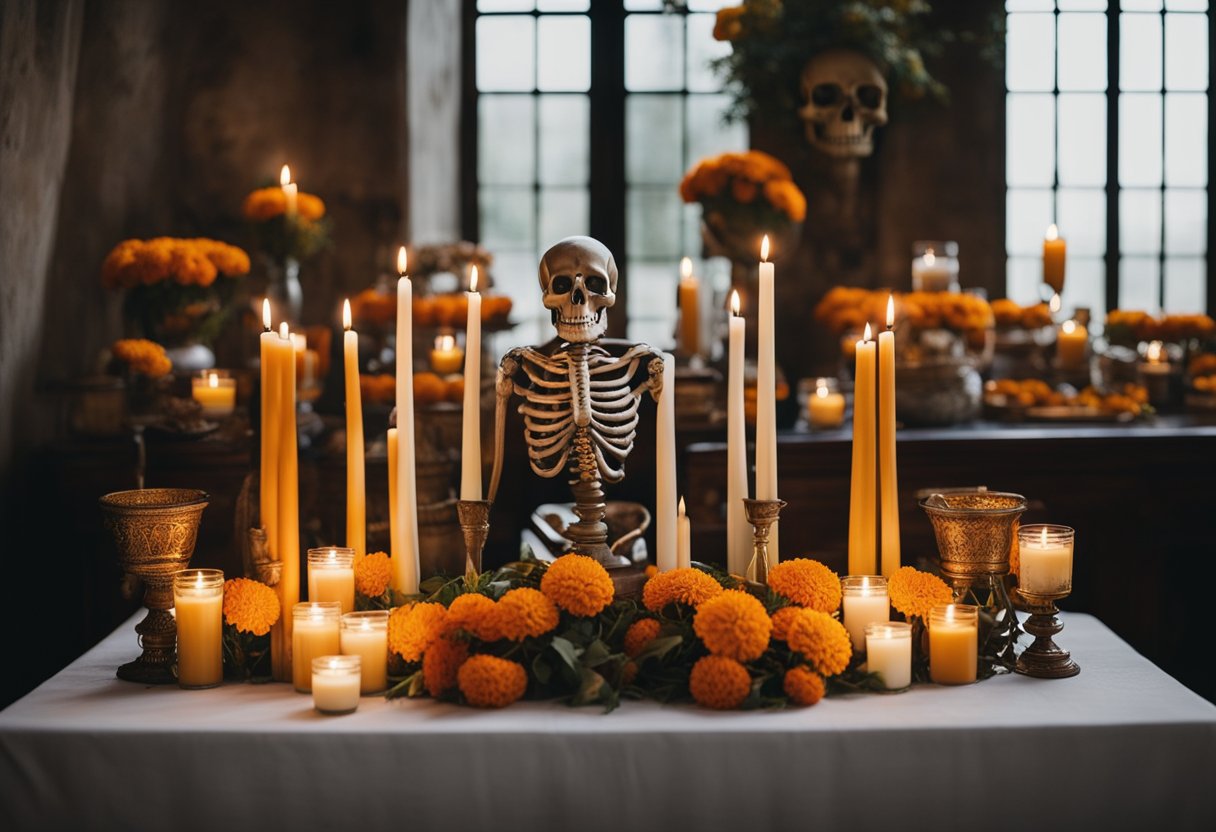
Updated On: April 22, 2024 by Panseih Gharib
As autumn deepens, two culturally rich festivals that honour the dead and mark the passage of time emerge with distinct traditions: Samhain and Day of the Dead. Samhain, a festival originating from ancient Celtic paganism, celebrates the end of the harvest season and the onset of winter, marking a time when the boundary between the worlds of the living and the dead is said to be thinnest. Traditionally observed from October 31st to November 1st, it is a time of reflection and celebration, recognising death as an integral part of the cycle of life.
In contrast, Día de los Muertos is a vibrant Mexican tradition that takes place from November 1st to 2nd, rooted in both indigenous Aztec rituals and Catholic customs. This festival is a joyful occasion that celebrates the lives of the departed, using altars, colourful marigolds, and offerings to welcome spirits back to the world of the living for a brief visit. The heart of this tradition lies in the belief that death is not the end but rather a continuation and that once a year, the deceased returns home to enjoy the pleasures they once knew in life.
Origins of Samhain and Day of the Dead
Samhain and the Day of the Dead originate from vastly different cultures, yet both celebrations intertwine death with life in a meaningful commemoration.
Samhain: Traceable to ancient Celts, Samhain marked the end of the harvest season and the beginning of winter. Celebrated from October 31 to November 1, this festival symbolised the boundary between the world of the living and the dead, at a time when it was believed that this divide was at its thinnest. As a pagan tradition, this day involved rites and rituals to appease deities and spirits. The spread of Christianity transformed Samhain’s observances, merging with All Saints’ Day to form Halloween, yet still retaining its focus on the supernatural and remembrance of the dead.
Day of the Dead: Rooted in Aztec traditions and blended with Christian practices, Día de los Muertos is celebrated predominantly in Mexico from October 31 to November 2. This vibrant festivity honours deceased loved ones through altars adorned with marigolds, offerings of food, and the iconic sugar skulls. Its essence lies in the joyous remembrance that transcends mourning, maintaining a spiritual connection with those who have passed on.
| Tradition | Culture | Current Observance Period |
|---|---|---|
| Samhain | Celtic | October 31 – November 1 |
| Day of the Dead | Aztec/Christian | October 31 – November 2 |
While dissimilar in origin, both Samhain and the Day of the Dead celebrate the cyclical nature of life, reminding us to honour ancestral ties and to perceive death as a part of life’s continuum.
Significance of the Festivals
In exploring the rich tapestry of global cultures, we recognise the profound importance festivals hold in honouring the dead. Traditional observances such as Samhain and Day of the Dead reflect deep-rooted beliefs surrounding the spiritual journey after death, each with unique rituals and significance.
Understanding Samhain
Samhain marks the Celtic calendar’s end of the harvest season and the onset of winter. It is believed that on this night, the veil between the worlds thins, enabling closer interaction with spirits and the supernatural realm. Traditionally, celebrants light bonfires, offer food and drink to the ancestors, and engage in divinatory practices. The rituals performed celebrate the connection with the ancestral spirits and respect for the cycles of life and death.
Understanding the Day of the Dead
Contrasting Samhain’s sombre tone, the Day of the Dead (Día de los Muertos) is a vibrant Mexican festival steeped in indigenous and Spanish traditions. It is a time when families welcome back the souls of the dead for a joyful reunion. Altars laden with offerings such as marigolds, candles, and sugar skulls honour the departed. The celebratory nature of the Day of the Dead underscores a collective ethos that views death not as an end but as a natural part of life’s continuum.
Cultural Practices and Traditional Activities
In discussing the rich cultural fabric of festivities like Samhain and Día de los Muertos, we recognise the importance of traditional activities that bring to life the customs and cultural significance of each celebration.
Samhain Customs
Samhain is considered one of the ancient Celtic fire festivals, and it marks the end of the harvest season and the beginning of winter. It is traditionally celebrated from 31 October to 1 November. Bonfires play a central role in Samhain celebrations, serving as a communal beacon for festivities that were once meant to ward off fairies and evil spirits. The act of guising or mumming, where participants don costumes and visit homes to perform in exchange for food, has evolved into modern-day Halloween traditions. Food and drink associated with Samhain often incorporate the harvest, featuring apples, nuts, and seasonal meats.
Day of the Dead Customs
Día de los Muertos, or Day of the Dead, is a vibrant Mexican festival celebrated mainly on the 1st and 2nd of November. Though rooted in indigenous cultures, it has syncretised with Christian traditions. Altars or ofrendas are the focal points of the celebration, where families honour their deceased loved ones with candles, photographs, Calaveras (sugar skulls), their favourite food and drink, and bright marigolds. It’s a time when the living commune with the dead, believing that the spirits return to enjoy the offerings. Public spaces are often adorned with colourful decorations, lanterns, and papel picado, while people dress up, not uncommonly as skeletal figures, to participate in processions and festivities.
Seasonal Significance and Astrological Associations
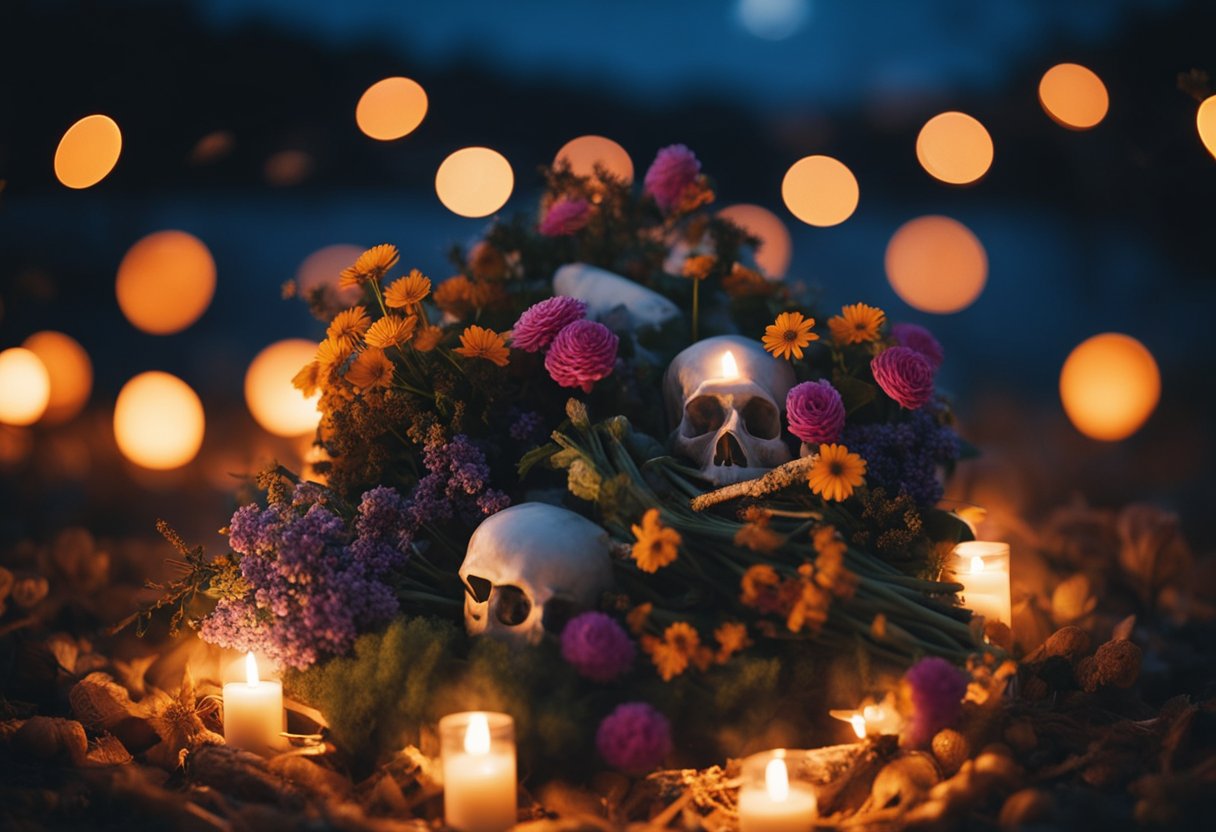
As we observe the calendar’s progression, Samhain marks a pivotal point in our cycle of seasons. Coinciding with mid-autumn, this ancient Celtic New Year celebrates the end of the harvest and the onset of winter. It’s a liminal time when the boundaries between the physical and spiritual worlds are believed to thin, allowing a closer connection with the deceased.
In astrological terms, Samhain falls during Scorpio season, a sign synonymous with transformation and the deeper mysteries of life. This period powerfully reflects the themes of transition and reflection, mirroring nature’s shift as the sun’s light wanes and the days grow shorter.
Furthermore, this festival is traditionally observed from 31 October to 1 November, harnessing the essence of transition as we honour the past and prepare for the new year. The wheel of the year turns towards its darkest point, culminating at the Winter Solstice, marking the longest night before the sun’s rebirth.
| Significance | Association |
|---|---|
| End of Harvest | Transition |
| Celtic New Year | Renewal |
| Mid-Autumn | Reflection |
| Liminal Time | Spiritual Connection |
| Winter & Darkening Days | Introspection |
| Scorpio Season | Transformation |
| Approach of Winter Solstice | Rebirth of Sun |
Through our traditions, we understand that acknowledging these rhythms of nature and the cosmos enhances our connection to the cycles of life and death, growth and dormancy, and light and darkness. Samhain’s placement in the seasonal and astrological calendar reminds us of our place in this eternal cycle.
Spiritual and Religious Elements
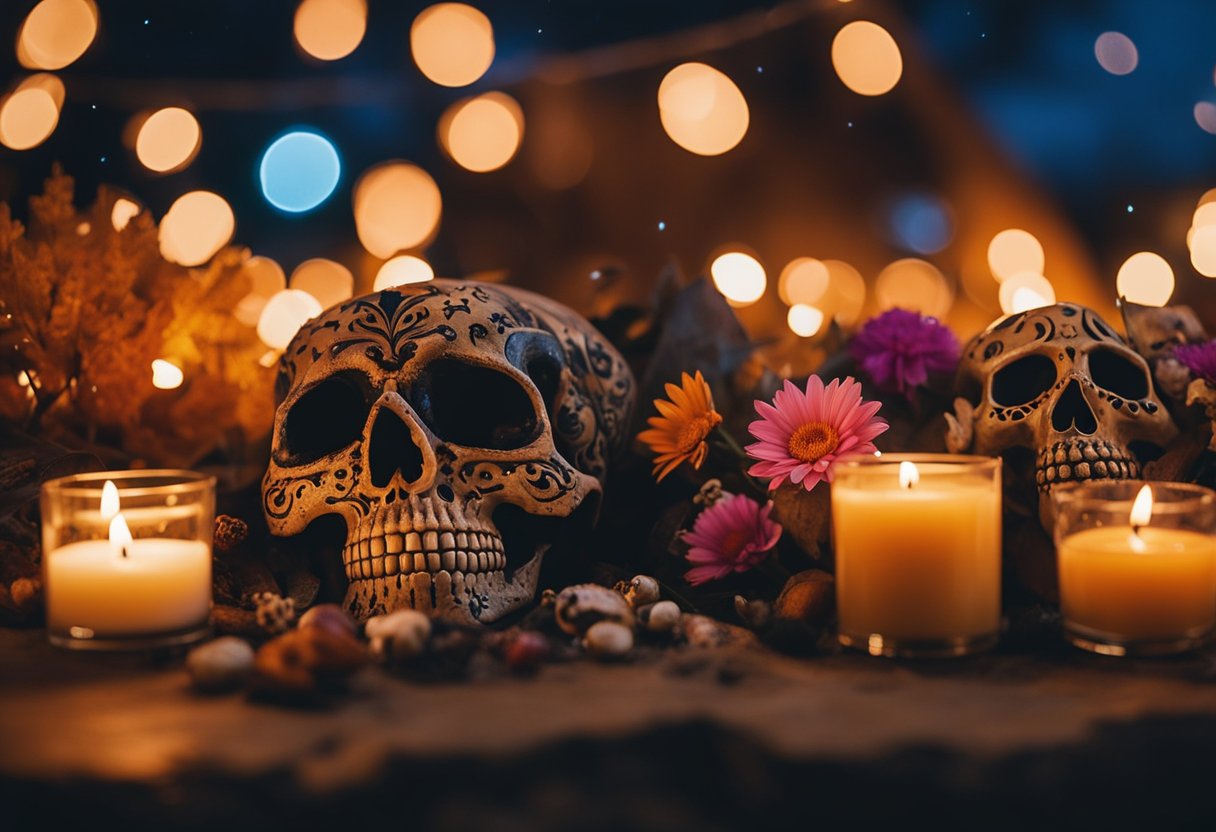
The spiritual traditions of Samhain and the Day of the Dead are steeped in ancient beliefs and theologies that resonate through their modern-day observances. Each retains unique practices that underline the cultural significance of honouring the dead.
Samhain’s Pagan Roots
Historically, Samhain marked the end of the harvest season and the beginning of winter for the Celts. We recognise it as a time when the boundary between the physical world and the Otherworld becomes porous, enabling gods and deceased spirits to pass through to our realm. During Samhain, pagans engage in ceremonies to connect with the spirit world, often involving fire rituals and divination. It is a profound moment meant to honour the dead and appease the deities who were believed to walk among the living.
Day of the Dead’s Catholic Influence
In contrast, the Day of the Dead (Día de los Muertos) is imbued with Catholic orthodoxy, owing to the Catholic Church’s influence in colonising lands where indigenous traditions prevailed. The holiday coincides with All Saints’ Day and All Souls’ Day, hybridising native Mexican beliefs and Catholic teachings. People construct altars, offer prayers, and present offerings to saints and martyrs. The Day of the Dead is a testimony to how ancient customs can adapt, merging with religious elements such as the masses conducted by the Catholic Church for souls in purgatory.
Communal and Social Aspects
In the celebration of Samhain, our Irish ancestors marked the end of the harvest season with much revelry. It was a crucial time when feasting was not just about food; it symbolised the community’s successful gathering of crops. Our ancient customs included both practical and ritualistic elements; we would light bonfires to ward off evil spirits and gather to share stories of the year’s work.
- Communal gatherings: Central to Samhain, featuring feasting and storytelling
- Crops and harvest: Marked end of harvest, preparing for winter’s scarcity
The modern Irish still honour these traditions by hosting Samhain festivals where dancing, live music, and storytelling often take centre stage. These gatherings are not only a nod to our history but also reinforce our bonds. The prevalence of these practices affirms our respect for the cultural wealth that Ireland possesses.
- Host traditions: Irish festivals with music and dancing
- Storytelling: Sharing of folk tales and legends
Transitioning to the Day of the Dead, although not a tradition born from Irish soil, is a vivid communal celebration in Mexican culture. Families and friends gather to remember their departed loved ones, erecting altars and sharing meals. It’s an event where the separation between life and death blurs, and the community rejoices in remembrance rather than mourning.
- Community involvement: Families and friends build altars and share meals
- Celebratory aspect: Joyful remembrances, not mourning
Comparatively, Halloween originates in Samhain but is now mostly associated with trick-or-treating and costumes within many communities, including ours. It represents a lighter, more commercial interpretation of the end of the harvest, lacking the depth of connection seen in traditional or religious rites but still a time for communal joy and hosting lively celebrations.
- Halloween traditions: Trick-or-treating, costumes
We, as a society, maintain a complex relationship with these autumnal festivities, each serving different cultural and communal purposes, yet all rooted in the human need to connect, remember, and celebrate collectively.
Symbolism and Iconography
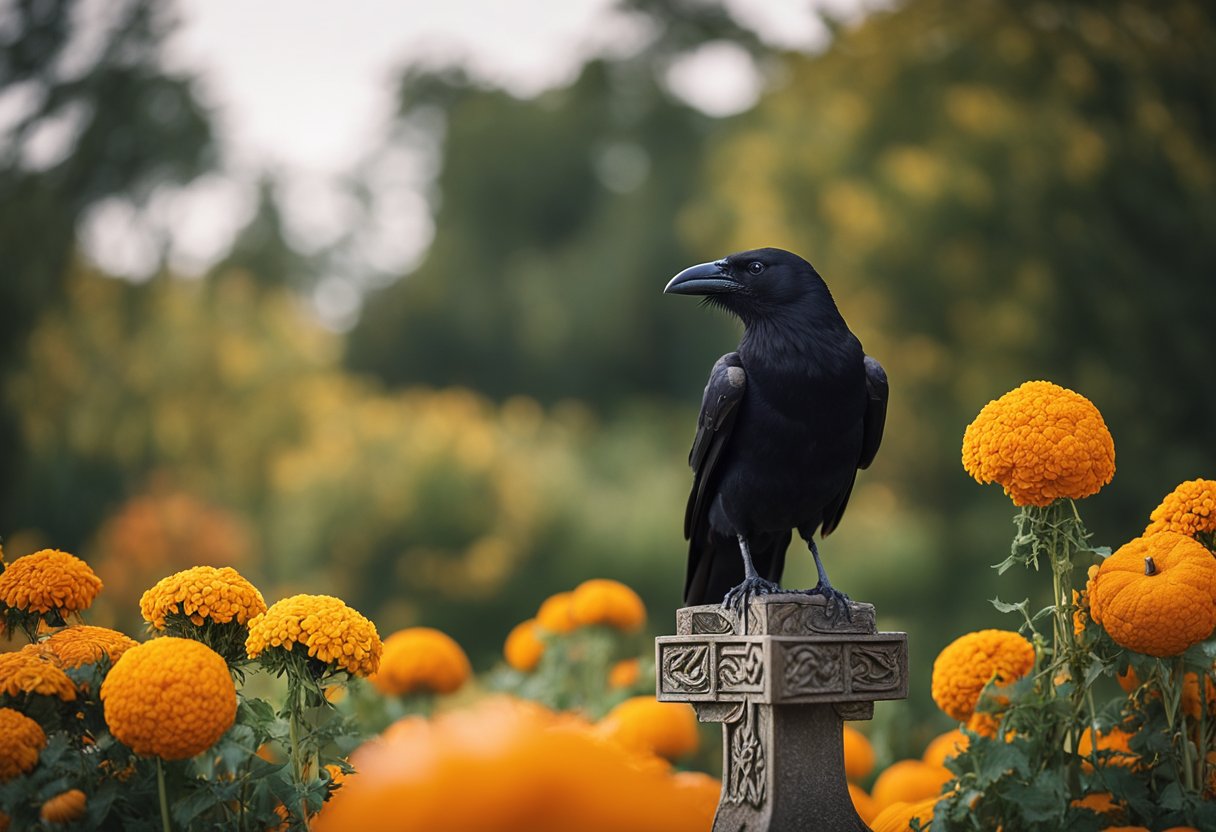
In our discussion of autumnal celebrations, the imagery most recognisable in Samhain and Day of the Dead (Día de los Muertos) festivities is both profound and symbolic. Each element, from pumpkins to calaveras, carries significant cultural importance.
Samhain:
- Jack-o’-lanterns: Originating from Irish folklore, these carved pumpkins or turnips are lit with candles to ward off evil spirits. Unlocking the Otherworld: 12+ Samhain Symbols and Their Significance
- Altars: In Wicca and modern Pagan practices, altars honour deceased loved ones and deities, featuring items like candles and seasonal lanterns to represent light and guidance.
Day of the Dead:
- Calaveras: These sugar skulls symbolise death and rebirth, serving as offerings to the deceased.
- Altars: Families construct altars decorated with bright marigolds, photos, and candles to welcome spirits back to the realm of the living for a reunion. Traditions and Change: The Transformation of Día de los Muertos in the…
Both traditions deeply reflect on the cycle of life and death, embracing the belief that the veil between worlds is thinnest at this time of year. The use of lanterns and candles in both Samhain and Day of the Dead is a testament to the universal human desire to find light in the darkness, guiding souls and warming hearts during these revered times.
Convergence with Other Traditions
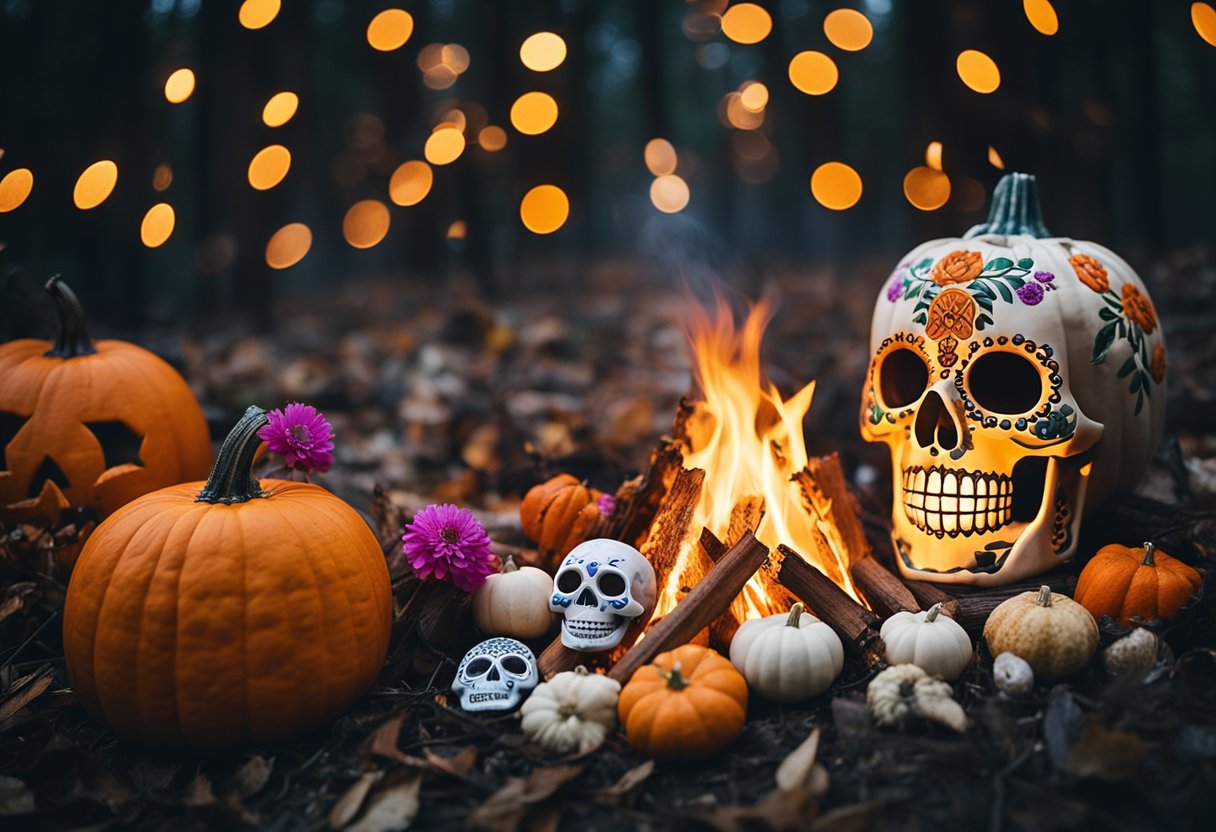
In examining Samhain and Día de los Muertos, we find intriguing intersections with other cultural practices. Samhain, traditionally celebrated from 31 October to 1 November, marks a liminal time in the Celtic calendar when the veil between worlds is believed to be thinnest. This period of transition is shared with other festivals, such as Imbolc and Lughnasa, which celebrate the beginning of spring and the harvest season, respectively.
While Samhain is rooted in Celtic regions like Ireland and Wales, its influence is seen in various forms globally. The wheel of the year, an integral part of Celtic tradition, also features celebrations of seasonal cycles, which are essential to pastoral life and pivotal for activities such as cattle rearing.
| Samhain Traditions | Similar Practices |
|---|---|
| End of harvest | Lughnasa |
| Honouring ancestors | Día de los Muertos |
| Preparing for winter | Imbolc transition |
Día de los Muertos originates from pre-Hispanic civilisations and converges with All Saints’ Day ceremonies, sharing the 1 November date. Although each maintains distinct rituals, the fundamental aim to honour ancestors and the deceased is a resonant theme.
In folklore, the tale of Nera, associated with Samhain, echoes myths found in other cultures, where spirits or the supernatural walk among the living during such thresholds.
Our exploration of these traditions reveals a rich tapestry of convergent practices, where the essence of honouring the past and preparing for the future unifies disparate cultures. We acknowledge the changing seasons and life cycles, embodying the belief that understanding them deepens our connection to the world we share.
Modern-Day Observances and Adaptations

In today’s world, Samhain and the Day of the Dead remain vital cultural holidays. While Samhain, celebrating the end of the harvest season, has traditional Wiccan roots and marks a time to honour the cycle of life and death, the Day of the Dead originates from a fusion of Mesoamerican beliefs intertwined with Catholic customs. Here, we examine the contemporary manifestations of these age-old traditions.
Samhain: We observe it as a time when the veil between our world and the spirit realm thins. Contemporary Wiccan communities often gather to perform rituals, light bonfires, and honour ancestry. Participants often wear costumes representing different aspects of nature or the supernatural. Some practices from these Samhain celebrations are echoed in the modern secular holiday of Halloween.
Day of the Dead: This festival has vivid costumes and symbolic sugar skulls. Families construct altars called ‘ofrendas’ to pay homage to the departed. The cultural traditions include the creation of marigold paths to guide spirits home, the sharing of the deceased’s favourite foods, and communal celebrations that are both joyous and solemn.
The festival aspect is crucial here as it promotes community unity and the remembrance of loved ones. In certain regions, All Souls’ Day integrates into this festive period, further expanding admiration for the deceased with church services and prayers.
Adaptations of these holidays blend cultural practices, with Wiccan elements being introduced to mainstream Halloween celebrations and the iconic imagery of the Day of the Dead increasingly recognised globally. In essence, these holidays encourage us to reflect on our place in the life cycle and to appreciate the enduring bond we share with those who have passed.
Reflection and Remembrance
In our observances of Samhain and Día de los Muertos, we embrace solemn traditions centred on reflection and remembrance. These traditions underscore our deep connection with the souls of the deceased, allowing us to honour their memories in many heartfelt ways.
Samhain is marked by the ancient Celtic practice of honouring the dead. This period of introspection is believed to thin the veil between the world of the living and the realm of the dead. We light candles and offer mementoes at gravesites, communing in silent respect for those who have passed. It’s a pivotal moment when Pagans engage in rituals to commemorate life cycles, acknowledging the importance of both life and death.
Día de los Muertos, on the other hand, reflects a vibrant amalgamation of indigenous and Catholic Church teachings, which the latter introduced during colonial times, including the veneration of saints. This period of remembrance in Mexico involves building colourful altars adorned with flowers and cherished objects of the departed. Families gather to share stories and meals, creating a tapestry of communal mourning and celebration. It’s a dynamic time when the living intentionally connect with the souls of the dead, who are believed to return home to enjoy the offerings.
| Samhain | Día de los Muertos |
|---|---|
| Reflective and solemn | Vibrant and celebratory |
| Thinning of the veil | Return of souls |
| Candlelight vigils | Altars (ofrendas) |
| Honouring the ancestors | Feasts and family gatherings |
In embracing these traditions, we collectively offer a space for the departed to be revered, thus ensuring their legacies endure within our shared histories. This reverent time allows us to ponder our own existence while celebrating those who have shaped our individual and cultural identities.
Educational and Cultural Significance
When exploring the educational and cultural significance of Samhain and the Day of the Dead, it’s essential to understand their roots and the traditions they uphold. Both festivals serve as a means for communities to connect with their ancestors, fostering a sense of continuity and remembrance.
Samhain, originating from ancient Celtic traditions, marks the end of the harvest season and the beginning of winter. It is considered a time when the veil between the living and the deceased is thinnest, allowing for communication with the spirits. This festival educates about pagan beliefs and the importance of seasonal cycles in agrarian societies.
On the other hand, the Day of the Dead is a vibrant Mexican tradition celebrated to honour the dead. It is recognised for its elaborate altars, offerings, and iconic sugar skulls, educating individuals on the importance of honouring the deceased and acknowledging death as a natural part of life.
| Samhain | Day of the Dead |
|---|---|
| Celtic origins | Mexican heritage |
| Nature cycles | Family reunion |
| Ancestral spirits | Celebration of life |
Our rituals and traditions around death teach us about cultural attitudes towards the end of life and remembering those who’ve passed. Through educational programmes and community involvement, we highlight the universality of death and the different manners in which it is observed and respected across cultures.
In conclusion, these festivals are more than dates on a calendar — they are intrinsic parts of our cultural and educational frameworks. They remind us of our heritage and reinforce the bonds within our communities while also sharing the universal experience of commemorating our ancestral roots.
FAQ
What are the key differences in origins and practices between Samhain and the Day of the Dead?
Samhain, an ancient Celtic festival, marks the end of the harvest season and the onset of winter. It was a time when the boundary between the worlds of the living and the dead was believed to be blurred. Samhain celebrations involved bonfires, feasts, and honouring the dead. In contrast, the Day of the Dead is a Mexican tradition honouring deceased loved ones with ofrendas, marigolds, and sugar skulls.
How have Christian and Catholic beliefs influenced the celebration of Samhain and the Day of the Dead traditions?
Christian and Catholic beliefs have overlaid older traditions with new meanings. The church introduced All Saints’ Day and All Souls’ Day partly to supplant the pagan customs of Samhain with a Christian observance. Similarly, the Day of the Dead coincides with these Christian holidays and includes church services and prayers alongside indigenous customs.
In what ways did the Celtic people observe Samhain, and what customs did it involve?
The Celts observed Samhain with rituals that included lighting enormous communal bonfires and engaging in divination practices. People would wear costumes, often made of animal heads and skins, which is a custom thought to be an antecedent of modern Halloween costumes. Houses were adorned with carved turnips to ward off evil spirits.
Does the Day of the Dead have its roots in Samhain rituals, or is it an independent tradition?
The Day of the Dead is an independent tradition with roots in the pre-Hispanic cultures of Mexico. It has no direct link to Samhain rituals, although both festivals are dedicated to honouring and remembering the dead and occur at a similar time of year.
How does the celebration of Halloween compare to that of Samhain and the Day of the Dead?
Halloween has evolved from the ancient Celtic Samhain and retains aspects like costume-wearing and a supernatural theme. However, Halloween typically involves trick-or-treating and jack-o’-lanterns rather than the traditional Samhain practices of bonfires and divination. The Day of the Dead is distinct from both, focusing on celebrating deceased ancestors and its unique symbols, such as skeletons and altars.
Is the observance of All Hallows’ Eve considered synonymous with the Day of the Dead celebrations?
No, All Hallows’ Eve, or Halloween, is not synonymous with the Day of the Dead. Despite occurring around the same time, Halloween is largely about jest and spookiness, whereas the Day of the Dead is a reverent occasion for honouring ancestors and embracing the continuity of life and death.






